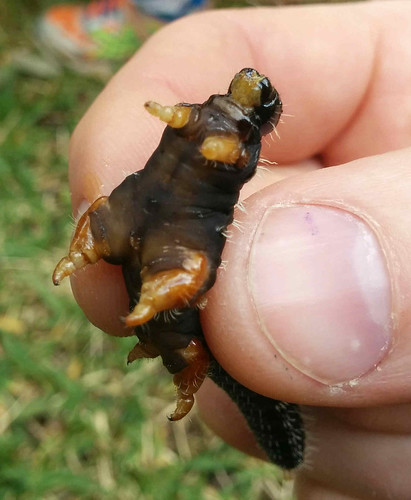Perga dorsalis
First up it’s not a caterpillar, it totally looks like one but it’s not! It took a bit of searching to find it’s actually a Steel Blue Sawfly Larvae. Sawflys are large flying insects that are closely related to wasps. Caterpillars on the other hand are the larvae of butterflies and moths. The Steel Blue Sawfly Larvae is commonly known as a “spitfire” or “spitfire caterpillar”.

I found this one out the back while putting the clothes on the line. It was crawling on the grass near a small hole that looked like it had been recently dug by a bandicoot. Spitfires are distinctive looking, quite a chunky things growing up to 8cm long. Their bodies are black and covered by sparse tufts of short white hairs. They have six large distinctive legs near the front of their body, this gives the larvae the appearance of having a long tail. The tip of the tail is yellow.

The Spitfire name comes from the larvaes behaviour of excreting a smelly yellow liquid from it’s mouth as a defence when disturbed. Growing up we were always told that it would burn and cause an irritating “bite”, this one had a spit in my hand when I picked it up and it didn’t do anything. It was pretty yuck though, I wiped it off.
Spitfires like to clump together in groups during the day, presumably for protection, then at night they venture out alone to feed. By coincidence I’d observed a clump of them on a small shrub only 2 weekends ago while visiting Leura in the Blue Mountains. I took a photo because it looked interesting but at the time I didn’t know what they were.

Spitfires are active during late winter and spring, after which they burrow into the soil to make a cocoon and pupate. They can remain in the soil for two or three years before emerging as an adult saw fly. I think the one I found was trying to bury itself or had just been dug up. I had no idea what it was at the time, so after picking it up and taking the photos I placed it in a Banksia tree. It would have been double pissed at that because they only eat eucalyptus leaves! Oh well, hope it found it’s way back down to the ground.

I couldn’t find much information of where they live but it looks like they are considered to be an Australian native. From the various sites and Atlas of Living Australia occurrences they are at least found in Eastern Australia from Brisbane in the north down through Victoria in the south
Resources and References